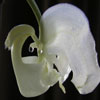|
|
|
|
 |
Email Address Recovery or Password Reset |
Use our Change Password page, and you can set a new password, or if you don't remember which email address you
registered with, the same page may be able to suggest it based on another you enter.
|
|
|
|
|
| |
Flasks of
Coryanthes alborosea var. alba 'Arnie' × self |
|
| |
|
|
| |
| Number: |
TN4485 |
| Name: |
Coryanthes alborosea var. alba 'Arnie' × self
|
| Type: |
self (What's that?) |
|
Seed Donor: |
Arnold Gum
|
|
Click to Enlarge

Pod Parent Flower |
|
|
|
| |
Culture Notes from Donor: Parent plant: Temperature range W (70-90°F)
Comments: Parent plant: Small plant. Beautiful, gleaming white flowers are almost ghostlike and fragile. Flowers last about 3 days. Nice grower but prefers warm.
For additional origin/habitat information supplied courtesy of
Charles and Margaret Baker, see further below, near the bottom of this page.
|
Temperatures we attempt to use in the lab & greenhouse:
| For Species: |
|
Spring, Summer, Autumn, Winter: days average 89°F, nights 70°F; best fit is Warm 90-70°F
(Source:
Baker's Web OSC) |
|
About the name...
| Etymology of |
alba |
|
From Latin "albus" white.
(Source:
Brown 1956) |
| Etymology of |
alborosea |
|
From Latin "alboroseus" white-pink.
(Source:
Mayr & Schmucker 1998) |
| Etymology of |
Coryanthes |
|
From Greek "korys" helmet; "anthos" flower.
(Source:
Pridgeon 1992) |
| Pronunciation of |
alba |
|
AL-ba
(Source:
Hawkes 1978) |
| Pronunciation of |
Coryanthes |
|
ko-ree-AN-theez
(Source:
Pridgeon 1992) |
|
If you would like to direct someone to this web page, please copy and paste this URL into your email:
http://troymeyers.com/d?014485
| Flask Information |
| Availability: |
We have sold all of the flasks for this item. |
| You should: |
Consider getting individual plants or compots instead of a flask.
You can place a "Notify Flask Recipients" Request, and either we or a flask recipient may contact you when plants are available.
You may also place a "Notify Retries" Request, and if an identical pollination (the same parents) is done again, we'll let you know.
You may reserve a flask, but it's very unlikely you'll get one ...this could only happen if we found a flask that we didn't know we had. |
| Yield Estimate: |
300 plants (based on flask surveys done 11/05/2004 through 04/11/2005)
|
| Plantlet Sizes: |
From many flasks 70 - 130 mm plants (based on flask surveys done 01/07/2005 through 07/07/2005)
From one most recently surveyed flask 70 - 100 mm (07/07/2005)
|
|
You might also want to:
|
View the seed assay for this item.
View items of the same species.
View items of the same genus.
|
| Ordering Information |
| You are not currently logged in. |
|
You must be a registered user and be logged in to reserve a flask or place a notification request. Please log in:
|
|
 |
Email Address Recovery or Password Reset |
Use our Change Password page, and you can set a new password, or if you don't remember which email address you
registered with, the same page may be able to suggest it based on another you enter.
|
|
|
|
|
|
|
|
| |
The origin/habitat information below is supplied courtesy of Charles and Margaret Baker
The following information is based on the name of the plant provided by the donor, and assumes that the name is correct. If the plant has been misidentified, then the following information may not be correct.
This text is copyrighted by the Bakers and may not be reproduced without permission.
ORIGIN/HABITAT: Peru. Plants have been collected at 350 ft. (100 m) near
Iquitos in the Department of Loreto. These plants, which grow in hot,
tropical forests, are frequently associated with ant nests.
More about this information and the Bakers...
|
|
|
| |
|
|
|